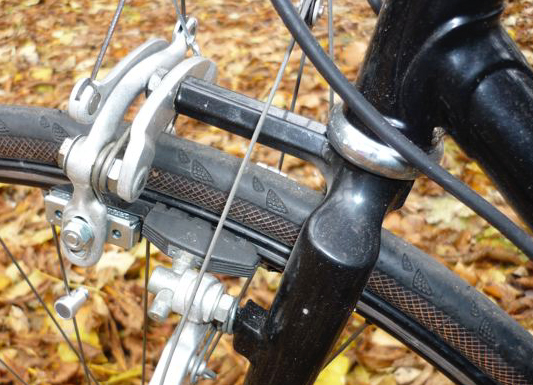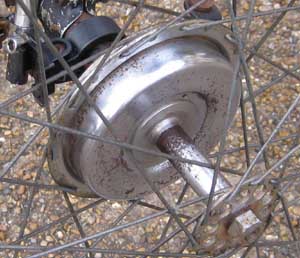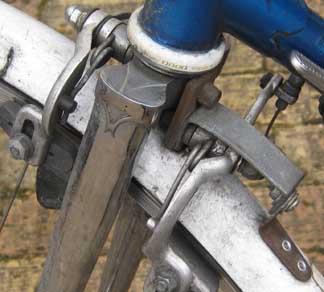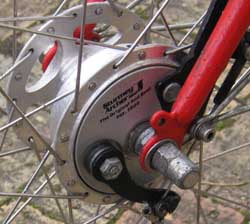Vol. 2, Issue 31 - Jan / Feb 2011
Posted: Friday 07th January 2011
The transformation to ‘on-line publishing’ for Cambridge Lightweight News seems to have gone smoothly and we are getting feedback showing that it is being picked up by hundreds of new readers.
Cycling clubs in the thirties, forties and fifties
Either side of WWII there existed a number of cycling clubs with a wider agenda than their sporting activities, often social or political. One which immediately springs to mind is the Vegetarian Cycling and Athletics Club which aimed to use sport to promote abstention from meat eating and show that it was compatible with athletic prowess. I do have quite a bit of information on them, thanks to P Simpson for allowing us to quote from his comprehensive history of the V C & A C.
I have also learned something about the Clarion clubs as much has been written about them in print and on the web, most probably because several exist to this day. They initially catered for members with a left-of-centre political leaning and have a fascinating history dating back to the days of the ‘Clarion’ news sheet in 1895. The club suffered a split in 2006/7 when the former secretary Charles Jepson pushed the socialist aspect of the club beyond what was acceptable to most members, who joined mainly for the cycling. The resulting split was not wanted by the committee but it was inevitable based on what happens in other organisations. Jepson formed The National Clarion 1895.
There were however other clubs which were open only to ‘card-carrying’ communists. I read about one of these in London but the name has slipped my mind (along with a lot of other information!). Does anyone remember these clubs? If so I, wonder if you would pass on what you know to me.
A further category of clubs were for members of the Catholic faith, their names usually incorporating St Christopher’s CC along with a place name. I would like information on these too please if you are able to help. I have searched for a history of the St Christopher’s clubs without success.
In addition there were Police clubs, Railway clubs, large company clubs and maybe even a club for Lyons Corner House Nippies and Showgirls from the theatres in London. They certainly ran well-supported (in numbers that is!) events for both at Herne Hill track events and they competed on proper track bikes – they weren’t ‘novelty’ races ridden on shopping and town bikes, as one may expect. “Co-operative” clubs also existed such as the Middlesborough Co-operative CC.
Any information on such clubs would be appreciated. I can be contacted by phone or email – preferably the latter – details at top of page.
In October we went to the Hampshire Section of the V-CC End of Season, Around the Harbours Ride which has always been a favourite of ours and we were not disappointed this time as there was a great turnout of about 30 classic lightweights. It is always a great social occasion on top of the ride through the Hampshire lanes, visiting the harbours where boat owners were busy ‘laying-up’ their boats for the winter. Patricia took her 1951 Gillott L’Atlantique which has a welded frame and I took my 1953 welded Mercian.
There were also several other welded frames on the ride and it brought back to mind a ‘tongue in cheek’ letter I had recently written to the Veteran-Cycle Club magazine in response to letters extolling the virtue of different plain and fancy-lugged frames. It went as follows:
“As well as riding classic lightweights at V-CC events I also mix with members of our local cycling clubs and so meet people with wider views of frame construction. A few years ago, before carbon and titanium became the norm, I was discussing frames with someone with a practical knowledge of frame building. I explained that I had two ‘modern’ steel machines, both 531 and hand-built to the same dimensions, and we were discussing why one felt light and lively whereas the other, a Bob Jackson, felt quite dead and sluggish in comparison. My companion asked if one was welded and one lugged, which they were, and he was willing to bet that the lively one was the welded one. Luckily I didn’t take the bet!
Some time later I was restoring a welded Gillott L’Atlantique for Patricia which was hanging in the shed from the seat bolt. I happened to turn round with a piece of wood which caught the frame sending out a ringing noise not unlike the triangle I was reluctantly allowed to strike now and then during music lessons at school! This made me think back to the above conversation and I discussed it from time to time with various riders on V-CC events. One told me that, amongst his collection, he had both a Higgins Ultralite and a welded Ephgrave and that they were two of his nicest machines to ride.
When it was built, Patricia found that her L’Atlantique had this light and lively feel compared to the rest of her collection. I have a rather rare early welded Mercian and yet again it has this lively feel.
Could it be that the ‘oneness’ of these frames gives them an edge over the frames built with lugs? We know that the welded frames are lighter but I feel there is more to it than this. Maybe the lugs have a deadening effect to the construction.
I sometimes wonder if one was contemplating a collection policy anew, which ideally would be a good thing to do before embarking on a willy-nilly collection as most of us do, maybe a collection of the welded frames made by most builders would give an interesting slant, in the main they would be much cheaper to acquire as they are not the top of most collectors list of things to buy. From time to time I have come across welded frames which originally had a very expensive finish and specification so not all were bought for cheapness.”
Rather conceitedly I wondered if the letter had encouraged others to bring their welded frames ‘out of the closet’ so to speak, now that the taboo had been broken. Since the letter was published several owners have come to me to agree with the theory whereas, before this, it was the unspoken subject or, ‘the elephant in the room’ in modern parlance.
I took two bikes to this Hampshire ride and decided to ride the Mercian when one or two riders spoke to me about welded frames before the start.
Since I got home I wish I had ridden the other one which was a 1949 Rotrax Super course. I took this one along in an attempt to shame the Hampshire riders into bringing out their Rotrax bikes. For those who don’t know, the Rotrax was built in Southampton (Hampshire) for the greater part of its life.
I’m sure several of the Hampshire riders have got one at home but they are very rarely seen on the section’s rides. Actually I have two, a 1949 Super Course and a 1957 La Premiere, by coincidence both dark green.
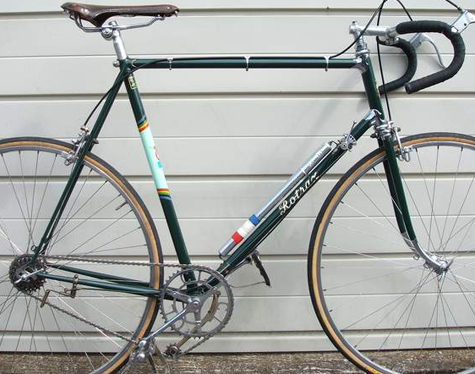
The 25” Super Course is shown above. It is an early version of the model with (solid) spearpoint head lugs. A short while later the spearpoints were drilled to make them look lighter and more decorative. This one is fitted with an Osgear 4-speed gear complete with detensioner lever and cable. Riders were obsessed with drive loss through gears in this post WWII period and the detensioner took pressure off the tension arm after the gear was selected. It is operated by rotating a small second lever on the outside of the gear change lever. Details of the gear and lugs can be found at https://www.classiclightweights.co.uk/bikes/rotrax-supercourse-rb.html
In this era of home custom-built bikes several owners replaced the smooth Osgear pulley wheel with the Cyclo ‘toothed’ version as seen here. I struggled to get this gear working smoothly until I used a freewheel with equal two-tooth difference between the sprockets – back in the 40/50’s they would probably be used with a one-tooth difference.
To make it up to the Rotrax for being snubbed in Hants I rode it in our November ‘Fireworks Ride’ in Cambridge. I had forgotten how nice it is to ride and how well the Osgear is working these days. Patricia rode her 1948 Paris Tour de France which had also been to Hampshire but not ridden.
https://www.classiclightweights.co.uk/ParisTourdeFrancePK1948.html
The Hampshire Section are organising a ride for Rotrax in 2011 but sadly it clashes with the UK’s biggest event for lightweights, The Reading Rally, organised every year by Terry and Pauline Pearce – a lot of riders feel an allegiance to this event as Terry and Pauline have probably done more than anyone to put the lightweight scene on the map here and the Reading is top of our ‘must not miss events’.
I have often been asked what the law is regarding brakes on a single speed machine. In the UK all bikes are required to have two brakes, each defined as an independent means of stopping. So any machine with a freewheel should have two brakes fitted. Jamming a foot on the front wheel doesn’t count I’m afraid.
On a fixed-wheel machine, the fixed-wheel counts as one brake, hence so many fixed bikes with just one brake. These are nearly always on the front wheel but this is a matter of choice. I suppose it seems to balance out the two methods of retardation with one being applied to each wheel.
So, all the posers we see, riding around cities often with no brakes, are breaking the law. How do they stop, you may ask. They have developed a technique where they jump the rear wheel into the air, then ‘lock’ their legs and when the wheel hits the tarmac they skid to a halt. No comment apart from “buy stocks in bicycle tyre manufacturers”!
On a slightly different thread, tricycles have their own braking problems, unless ridden on fixed when just one front brake on the front wheel will suffice just as on a bike. The problem arises when a trike (or barrow as they are known in the UK) has a freewheel, as is the case with most geared set-ups. One answer is hub brakes on the rear wheels but these need an anchor point.
Apart from that, most barrow boys have varied ways of doubling the brakes on the front wheel. If one of these is a hub brake it is simple but hub brakes are not the favourite choice of many. This leaves another option of a combination of cantilever and side-pull or centre-pull stirrup. It is when rider decides to utilise two side pull stirrups that the Heath Robinson element comes in.
Some use an extended brake bolt with two sets of stirrups both in front of the fork crown. Others do the same thing fore and aft, that is with one stirrup in front and one behind the fork.
For more on trike brakes see http://pedal-trikes.blogspot.com/2010/09/trike-front-brakes.html
Norris Lockley: Replied to a query on the Classic Rendezvous mailing list who kindly allowed us to reproduce it here as I am always talking about individual builds and what is ‘Gen’ and what is not. This could vary from club to club and area to area:
“The Simplex chainrings were the connoisseurs’ choice in the late 40s / early 50s if you couldn’t afford Stronglight’s 49 series. As with most double-ring set-ups of the period such as Gnutti, Agrati … the rings came with just 3-teeth separating the larger from the smaller ring, e.g. 52/49, 51/48, 50/47, 49/46. Beyond these combinations it was always possible to dismantle the rings and make up whatever combinations you wanted, bearing in mind of course the limitations for shifting the chain of the Simplex and similar rod-operated front mechs.
I used to tour extensively on Simplex rings and a 15-22 Packson Perfection 4-speed freewheel. I remember to my eternal joy pulling into a bike shop in Vernon along the Seine valley above Paris and spotting a SIMPLEX double ring in the 48/45 combination. Naturally I bought it in order to avail myself of some real LOW touring ratios … Of course the 3-arm Simplex rings were also available made from duralumin and a choice of cranked or straight arms was available to alter the offset of the rings. Not many of the alloy combinations seem to have lasted to this day.
I think that this combination was the lowest offered by Simplex on the three arm model. If you needed lower ratios you bought the 5-pin fitting rings that would start with mid-range 40-something teeth coupled up to mid-30s.
Durax cranks were, apart from the exotic Duprat hollow ones and some Stella ones, THE cranks to ride. Generally the 3-arm models came in two models, the Service de Course which was a robust crank of square section and then the highly desirable – and I hope that you have this model bike – fluted one. This was of altogether lighter and more elegant construction but benefitted even more from having four flutes gouged , or should that be milled, along the length of each corner of the crank, making it almost, in a sense, octagonal.
The flutes were very often somewhat coarsely cut but the gen-trick in those days was to pick out the flutes in a contrasting colour to the colour of your frame if you could match the flutes to the colour of your frame’s head or seat tube’s contrasting panel then that was ACE. In one-upmanship
Terms the next trick was to buy a PIVO stem and to paint its flute to match with the cranks.
Certain inveterate cycle cranks such as myself have been known to use a spare pair of Durax fluted cranks as sublime handles on the doors of our cycle ateliers.
Durax might not have had the best chrome-plated finish in the glass showcase, but they were known for not breaking. I have adverts in old magazines for DURAX cranks, but the name of the company other than DURAX is not shown, nor is the firm’s address, although I suspect that it would be
somewhere in the St Etienne region.”
Ed. This Gen business would cover all aspects of a bike build and Eric Hall was telling me how they all used Alp brake levers paired up with Universal stirrups. When I checked my Frejus (my only bike with Alps) I was relieved to find that it too had Universal stirrups.
Mike Baker, Bromsgrove, V-CC. Adds his thoughts to Steve Griffith’s piece on Suntour gears:
I agree with your comments about Suntour gears in Cambridge Lightweight News, they had quality throughout the range which was far superior to Campag but what a pity they stopped production, some of the finest cycle components ever.
I have an ARX front, SVX rear on my 1980 Carlton coping easily with TA 44/35 rings and a Maillard 7-speed 13/28 freewheel, the inner plate of the front changer is bent inwards to improve upwards changes. Funny you should mention tension springs as I had one go on my VX GT, luckily I got a spare from a cycle jumble. The other bugbear is changing the top pulley on open cage models as it is all-in-one with the tension spring, good for positive changes but a devil to service. Did your know that even the non-index models will index change using a Shimano index lever, I have had them working well.
PS – I fitted the TA 38t 3-pin ring onto my 1950 Holdsworth La Quelda using Stronglight 3 pin steel cranks fitted with a TA 47t outer ring, a Benelux Tourist rear with rod front changer and a 16/28 5-speed works a treat.
(ED. Another proud owner ‘outing’ his welded frame. In this case a Holdsworth ‘La Quelda’. Gillott’s version was ‘L’Atlantique’. The Suntour changers introduced in the sixties heralded a great step forward in gear changing with their slant-parallelogram format allowing the pulley ” to track the angle of the freewheel sprockets maintaining a constant distance between the pulley and the sprocket” (as described in The Dancing Chain).
I think any rear changer will index if used with index levers as all the indexing comes from the levers, all the rear changer does is swing the chain from side to side in effect. Having said that some changers are better than others in doing this and also providing good chain tension throughout the range.)
Ted Tyndall responded to the tale about the pig in the carrier bag, dangling from the bars of a fixed-wheel in the last issue:
The article about taking the pig home did make us laugh. It’s one of the funniest cycling tales we’ve heard. When I was an apprentice and overhauling my first car (1935 Wolseley Hornet), I had to go to a scrapyard and get another gearbox for it. Having only my bike for transport, after I’d removed the box from the scrap vehicle (it had got pretty late in the day by then) I thought “how am I going to get it home” . So I hit upon the idea of putting in a canvas sack, tying it all up with rope, and wearing it as a backpack, with the bike’s carrier off-loading some of the weight once I was aboard. It was probably about four or five miles from the scrapyard at Barking back to Leytonstone, and a rather hazardous ride too as the gearbox with bell housing uppermost kept swinging from side to side ! When I arrived home I found that as I’d forgotten to drain the ‘box in my haste to get finished before it got dark, most of the oil contained within had drained out somehow, soaked the bottom of the sack, and really well lubricated the rear end of the Raleigh ! Just like the pig episode.
Len Lawson – responded to a piece in C L N 30:
I’ve just come across the Classic Lightweights website, and whilst having a browse around, spotted the article in the latest edition of Cambridge Lightweight News about pedal washers.
I was a racing cyclist with the West Suffolk Wheelers in the early 1960’s. I used to ride a Carpenter frame using a Stronglight chainset with alloy cranks, fitted with Chater-Lea pedals. As with many pedals of that era, being designed for the narrower steel cranks, the pedal spindles were not long enough to fully utilise the thicker alloy cranks. I suffered several instances of pedals rocking and then after a while falling out of the cranks, sometimes having to limp home from a club run using pressure on the other side of the chainset. I recall that the failure mode started with a hairline crack appearing between the hole in the crank which accepted the pedal, to the edge of the crank. Gradually it got worse till eventually the pedal rocked too much and fell out. This I found rather expensive, as I was earning only a pittance at the time and my wages were not really up to the regular replacement of Stronglight cranks, which were priced at the top end of the market.
So, since I was undertaking training in engineering at the time, I cleverly deduced that the answer to the problem would be a Chater-Lea pedal with a longer spindle. I wrote a letter to Chater-Lea explaining the problem, and received a nice letter back saying that they would look into it. And to my surprise a few months later, I received in the post a small parcel from Chater-Lea enclosing a complimentary pair of their pedals fitted with the new, longer pedal spindles.
I really liked the Chater-Lea pedals. However, having feet a little on the large side (size 10) the projections at the end of the front and rear plates of the pedals fouled against my shoes. So I simply took a hacksaw and cut them off ! It did take a while, as the side plates were made from stainless steel and my hacksaw struggled to get there, but eventually they were suitably modified for my use.
I still have my Carpenter frame, of which I was (and still am) very proud. It’s pencil-thin seatstays are a dream !
17” Gitane, 1960’s boys French racer orange with 24” tubs, Mafac Simplex, Stronglight Atom, Mavic etc . Very French !!! For free long term loan as my son has grow out of it.
WANTS: Left-hand Campag quill pedal with English threads; left-hand Williams C1200 crank OFFERED: I have a stock of surplus Sturmey 1/8 x 3-spline sprockets, most sizes, also some screw-on ones.
“You are all wrapped up for autumn as we here are heading into late spring. On a ride last week I encountered troupes of (vervet) monkeys chasing after flying ants emerging into the humid air. Without any road sense they (the monkeys) were a real hazard! But that’s Africa for you.”
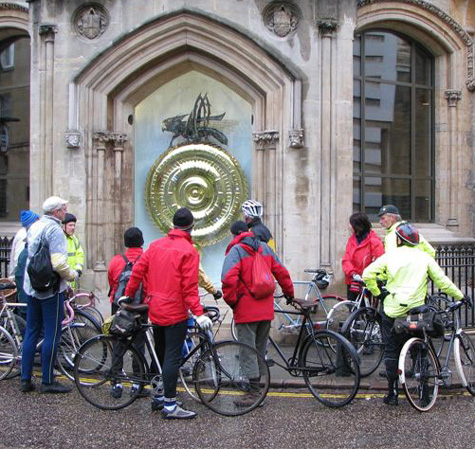
Happy New Year to all of our readers and here’s to many many, trouble-free miles on those classic lightweights.
Posted: Friday 07th January 2011
This article appears in the following categories.
Upcoming Events
Whether you are looking for a gentle social meet up, or a 100-mile ride browse the community’s upcoming events and plan your next weekend outing.

